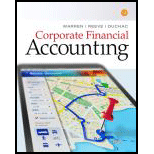
Bond investment: Bond investments are debt securities which pay a fixed interest revenue to the investor.
Debit and credit rules:
- Debit an increase in asset account, increase in expense account, decrease in liability account, and decrease in
stockholders’ equity accounts. - Credit decrease in asset account, increase in revenue account, increase in liability account, and increase in stockholders’ equity accounts.
To journalize: The bond investment transactions of S Products.
Explanation of Solution
(a)
Prepare journal entry for purchase of $120,000, 5% bonds of I Incorporation at 100% with an accrued interest of $1,000.
| Date | Account Titles and Explanations | Post. Ref. | Debit ($) | Credit ($) | |
| Investments–I Incorporation | 120,000 | ||||
| Interest Receivable | 1,000 | ||||
| Cash | 121,000 | ||||
| (To record purchase of M City bonds for cash) | |||||
Table (1)
- Investments–I Incorporation is an asset account. Since bonds investments are purchased, asset value increased, and an increase in asset is debited.
- Interest Receivable is an asset account. Since interest to be received has increased, asset value increased, and an increase in asset is debited.
- Cash is an asset account. Since cash is paid, asset account decreased, and a decrease in asset is credited.
(b)
Prepare journal entry to record the interest revenue received.
| Date | Account Titles and Explanations | Post. Ref. | Debit ($) | Credit ($) | |
| Cash | 3,000 | ||||
| Interest Receivable | 1,000 | ||||
| Interest Revenue | 1,000 | ||||
| (To record receipt of interest revenue) | |||||
Table (2)
- Cash is an asset account. Since cash is received, asset account increased, and an increase in asset is debited.
- Interest Receivable is an asset account. Since interest to be received is received, asset value decreased, and a decrease in asset is credited.
- Interest Revenue is a revenue account. Since revenues increase equity, equity value is increased, and an increase in equity is credited.
Working Notes:
Compute amount of interest received from I Incorporation.
(c)
Prepare journal entry for $60,000 bonds of I International sold at 101%, with an accrued interest of $100.
| Date | Account Titles and Explanations | Post. Ref. | Debit ($) | Credit ($) | |
| Cash | 61,100 | ||||
| Interest Revenue | 500 | ||||
| Gain on Sale of Investments | 600 | ||||
| Investments–I Incorporation | 60,000 | ||||
| (To record sale of I Incorporation bonds) | |||||
Table (3)
- Cash is an asset account. Since cash is received, asset account increased, and an increase in asset is debited.
- Interest Revenue is a revenue account. Since revenues increase equity, equity value is increased, and an increase in equity is credited.
- Gain on Sale of Investments is a revenue account. Since revenues increase equity, equity value is increased, and an increase in equity is credited.
- Investments–I Incorporation is an asset account. Since bond investments are sold, asset value decreased, and a decrease in asset is credited.
Working Notes:
Calculate the cash received from the sale of bonds.
| Particulars | Amount ($) |
| Cash proceeds from sale of $60,000 bonds
|
60,600 |
| Add: Accrued interest revenue | 500 |
| Cash received | $61,100 |
Table (4)
Calculate the realized gain (loss) on sale of $60,000 bonds.
| Particulars | Amount ($) |
| Cash proceeds from sale of $60,000 bonds
|
60,600 |
| Cost of bonds sold | (60,000) |
| Gain (loss) on sale of bonds | $600 |
Table (5)
Want to see more full solutions like this?
Chapter D Solutions
Corporate Financial Accounting
- Can you help me solve this general accounting question using the correct accounting procedures?arrow_forwardPlease explain the solution to this general accounting problem using the correct accounting principles.arrow_forwardI need help finding the accurate solution to this general accounting problem with valid methods.arrow_forward
- Principles of Accounting Volume 1AccountingISBN:9781947172685Author:OpenStaxPublisher:OpenStax College
 Intermediate Accounting: Reporting And AnalysisAccountingISBN:9781337788281Author:James M. Wahlen, Jefferson P. Jones, Donald PagachPublisher:Cengage Learning
Intermediate Accounting: Reporting And AnalysisAccountingISBN:9781337788281Author:James M. Wahlen, Jefferson P. Jones, Donald PagachPublisher:Cengage Learning

